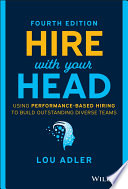

Behavioral interviewing is a technique that focuses on a candidate's past behavior as a predictor of future performance. The core premise is that past behavior is the best indicator of future behavior, particularly in similar contexts. This approach shifts the focus from hypothetical situations to real-life examples, allowing interviewers to assess how candidates have handled specific situations in the past. This method encourages a more structured interview process, where questions are designed to elicit detailed responses about past experiences, skills, and decision-making processes. Behavioral interviewing also helps to reduce bias, as it relies on objective evidence of a candidate's abilities rather than subjective impressions. By using this technique, organizations can improve their hiring decisions, leading to better team dynamics and enhanced performance.
Continue readingA competency model outlines the skills, knowledge, and behaviors that are necessary for success in a specific role or organization. This model serves as a foundation for the hiring process, ensuring that all candidates are evaluated against the same criteria. By defining the competencies required for a position, organizations can align their hiring practices with their strategic goals. This clarity helps interviewers focus on relevant attributes during the interview process, making it easier to identify candidates who possess the necessary traits. Additionally, a well-defined competency model can facilitate employee development, performance management, and succession planning, as it provides a clear roadmap for growth within the organization.
Continue readingJob descriptions are critical tools in the hiring process, serving as a communication bridge between the organization and potential candidates. A well-crafted job description not only outlines the responsibilities and requirements of the position but also conveys the organization's culture and values. This clarity helps attract candidates who are not only qualified but also aligned with the company's mission. Furthermore, job descriptions should be regularly updated to reflect changes in the role or the organization, ensuring that they remain relevant and effective. By investing time in creating comprehensive job descriptions, organizations can streamline their hiring process and improve candidate quality.
Continue readingCultural fit refers to the alignment between a candidate's values, beliefs, and behaviors and those of the organization. Hiring for cultural fit is crucial because employees who resonate with the company's culture are more likely to be engaged, satisfied, and productive. This alignment can lead to lower turnover rates and a more cohesive work environment. Organizations should assess cultural fit during the hiring process by asking candidates about their values and experiences, as well as by providing insights into the company culture. However, it is essential to balance cultural fit with diversity, as a homogenous workforce can stifle innovation and creativity. Therefore, organizations should strive to create a culture that is inclusive while still ensuring that new hires share core values.
Continue readingAssessment tools, such as personality tests, skills assessments, and cognitive ability tests, can enhance the hiring process by providing objective data about candidates. When used appropriately, these tools can supplement traditional interviews and help organizations make more informed hiring decisions. It is crucial to select assessment tools that are relevant to the competencies required for the position. Additionally, organizations should ensure that the assessments are valid and reliable, as poorly designed tools can lead to inaccurate conclusions. By integrating assessment tools into the hiring process, organizations can reduce bias and improve the overall quality of their hires.
Continue readingA structured interview process involves using a standardized set of questions and evaluation criteria for all candidates applying for a particular role. This approach minimizes the variability in interviews, ensuring that each candidate is assessed on the same basis. Structured interviews help reduce bias, improve reliability, and increase the validity of the hiring process. By utilizing a consistent framework, organizations can better compare candidates and make more objective decisions. Additionally, structured interviews can be more efficient, as they streamline the evaluation process and help interviewers stay focused on the competencies that matter most.
Continue readingContinuous improvement in hiring practices is essential for organizations aiming to adapt to changing market conditions and evolving workforce needs. This involves regularly reviewing and refining hiring processes, tools, and strategies based on feedback, data, and outcomes. Organizations should analyze their hiring metrics, such as time-to-fill, quality of hire, and employee retention rates, to identify areas for improvement. By fostering a culture of continuous improvement, organizations can stay competitive and ensure that they are attracting and retaining top talent. This iterative approach not only enhances the effectiveness of the hiring process but also contributes to the overall success and growth of the organization.
Continue reading